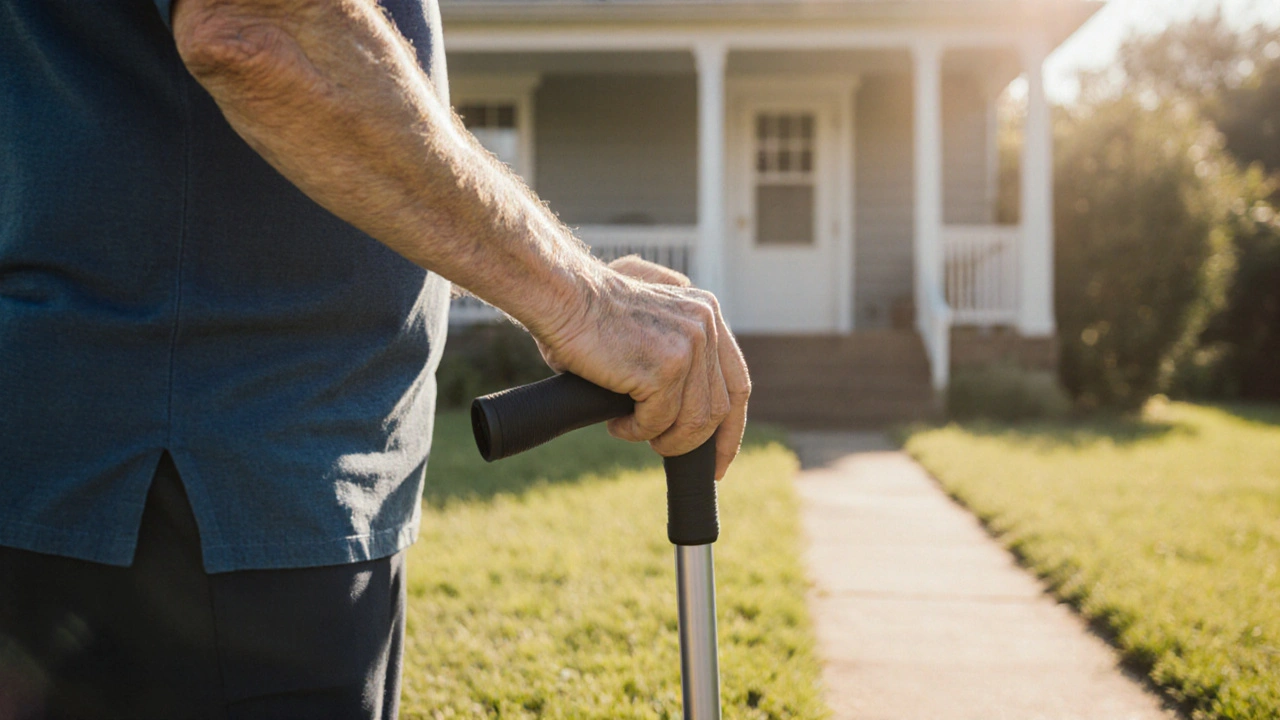Living with osteoarthritis (OA) means your joints often protest when you try to move, and pain can turn everyday tasks into hurdles. The good news is that a well‑chosen osteoarthritis assistive devices can take the pressure off the joints, keep you stable, and let you stay active longer. Below we break down the most common tools - from basic canes to high‑tech braces - and show how to pick, fit, and maintain them.
Key Takeaways
- Canes, walkers, and braces each address different stability and load‑distribution needs.
- Fit matters more than price; a properly adjusted device can prevent falls and reduce joint stress.
- Materials range from lightweight aluminium to carbon‑fiber; choose based on durability, weight, and budget.
- Most insurers cover basic canes and knee braces with a prescription; premium orthotics may need private funding.
- Regular inspection and cleaning extend the life of any assistive device.
Why Assistive Devices Matter for Osteoarthritis
OA is a wear‑and‑tear disease that slowly erodes cartilage, especially in the knees, hips, and hands. When the cartilage thins, bones grind, causing pain, swelling, and reduced range of motion. Assistive devices serve three core purposes:
- Redistribute load so the affected joint bears less weight.
- Provide stability to prevent slips and falls.
- Promote proper alignment, which can slow further joint degeneration.
Choosing the right tool can mean the difference between a short walk to the mailbox and a comfortable stroll through the park.
Primary Types of Assistive Devices
Below is a quick snapshot of the most frequently recommended devices. Each entry includes the first‑time definition wrapped in schema.org microdata so search engines can recognise the entities.
Canes are single‑point walking aids that shift a portion of body weight from the leg to the upper arm and shoulder. They come in four main styles: standard, quad, offset, and ergonomic.
Walkers provide a broader base of support with four legs and a hand‑grip frame. Some models include wheels (rollators) for smoother movement.
Knee braces encircle the knee joint, offering compression, stability, and sometimes hinge support to limit harmful motions.
Ankle braces work similarly for the ankle, helping with instability caused by OA in the lower leg.
Orthotic insoles are custom‑moulded shoe inserts that correct foot alignment, indirectly easing knee and hip stress.
Compression sleeves wrap the knee or elbow, offering gentle pressure to reduce swelling and improve proprioception.
Adaptive kitchen tools (e.g., jar openers, ergonomic knives) let you perform daily chores without over‑loading hand joints.
How to Choose the Right Device
Picking an aid isn’t a one‑size‑fits‑all decision. Follow these five criteria to narrow down the options:
- Joint(s) affected: Knee OA often benefits from braces, while hip OA may need a cane or walker.
- Balance confidence: If you’re prone to wobbling, a quad cane or walker offers a wider stance.
- Weight‑bearing capacity: Heavier users should consider aluminium or carbon‑fiber frames to avoid device fatigue.
- Activity level: For indoor use, a standard cane works; for longer outdoor walks, a rollator with a seat is more comfortable.
- Budget & insurance coverage: Basic canes are often covered with a prescription; custom knee braces may require out‑of‑pocket payment.

Fit and Adjustment Guidelines
Even the most advanced device will fail if it doesn’t fit you correctly. Here’s a step‑by‑step checklist for the most common aids.
- Canes: Stand upright with feet together. Adjust the handle height so your elbow bends at about 15‑20 degrees when you hold the cane.
- Check that the tip is snug on the ground; replace worn rubber caps.
- Walkers: Position the walker so the hand grips align with your wrist crease when standing straight. Test turning radius; it should be smooth without dragging.
- If the walker has wheels, ensure the front wheels lock when stationary.
- Knee braces: Wear the brace over a thin layer of clothing. Align the hinge (if present) with your knee joint line. Tighten straps evenly-too tight cuts circulation, too loose offers no support.
- Perform a short walk; the brace should feel firm but not painful.
- Orthotic insoles: Insert them into your shoes, ensuring the heel sits flush against the shoe’s back. Walk a few steps to confirm comfort.
- If you feel pressure points, the custom insole may need a re‑fit.
Maintenance & Longevity
Assistive devices are an investment-proper care keeps them safe and functional.
- Cleaning: Wipe metal frames with a damp cloth and mild soap. Avoid submerging aluminium or carbon‑fiber aids in water.
- Inspection: Check cane tips, walker wheels, and brace straps every month for wear.
- Replacement schedule: Rubber cane tips typically last 6‑12 months; replace sooner if you hear squeaking.
- Storage: Keep devices in a dry place away from direct sunlight to prevent material fatigue.
Cost, Insurance, and Funding Options
Pricing varies widely:
| Device | Typical Price (GBP) | Insurance Coverage |
|---|---|---|
| Standard aluminium cane | £20‑£35 | Usually covered with GP prescription |
| Quad‑base cane | £30‑£45 | Covered with prescription |
| Rollator walker | £120‑£250 | Partial coverage; may need private payment |
| Off‑the‑shelf knee brace | £40‑£100 | Often covered if prescribed by orthopaedic |
| Custom‑moulded knee brace | £150‑£300 | Limited NHS coverage; private insurance more likely |
| Orthotic insoles (custom) | £80‑£150 | Usually covered under NHS podiatry referral |
If you’re on a tight budget, start with a basic cane and revisit braces after a trial period. Many charities and local health boards provide loan schemes for walkers and rollators.

Real‑World Success Stories
Emma, 62, from Birmingham, struggled with knee OA for years. After trying painkillers, she switched to a custom knee brace fitted by a physiotherapist. Within two weeks, her pain dropped from 7/10 to 3/10, and she could walk her dog again without a limp. Mark, 58, prefers a quad cane for hip OA because it offers solid support on uneven garden paths while keeping his hands free for tools.
Potential Pitfalls & How to Avoid Them
- Over‑reliance: Using a device for every short step can lead to muscle deconditioning. Combine aid use with strengthening exercises prescribed by a physiotherapist.
- Incorrect height: A cane that’s too tall forces you to lean forward, worsening hip strain. Re‑measure after any weight change.
- Worn‑out parts: Loose straps on a knee brace can cause the joint to move unpredictably, increasing injury risk.
Frequently Asked Questions
Can I use a cane if I only have mild osteoarthritis?
Yes. Even mild OA can cause occasional pain after extended walking. A lightweight cane helps off‑load the joint and can prevent flare‑ups.
How often should I replace my cane tip?
Rubber tips usually last 6‑12 months, but if you hear squeaking or notice uneven wear, swap them immediately to keep traction.
Are knee braces covered by the NHS?
Standard off‑the‑shelf braces are often covered when prescribed by a doctor or orthopaedic surgeon. Custom‑moulded braces may need a separate referral to a specialist orthotist and sometimes a private payment.
What’s the difference between a walker and a rollator?
A walker has four static legs and is best for indoor use on smooth floors. A rollator adds wheels, a brake, and often a seat, making it more suitable for longer outdoor trips.
Can compression sleeves replace a knee brace?
Compression sleeves provide mild support and reduce swelling but don’t restrict harmful movements like a brace does. They’re great for low‑impact activities and as a complement to a brace, not a full substitute.
Next Steps for Readers
1. List the joints that give you the most trouble.
2. Match each joint to a device type from the table above.
3. Book a short appointment with a physiotherapist or orthotist to get a professional fitting.
4. Try the device for a week, noting comfort, pain levels, and any balance issues.
5. Adjust or switch devices based on those observations.
Remember, the right assistive device is a partnership between your body and a piece of well‑designed equipment. With proper selection, fitting, and care, you can keep moving confidently despite osteoarthritis.




